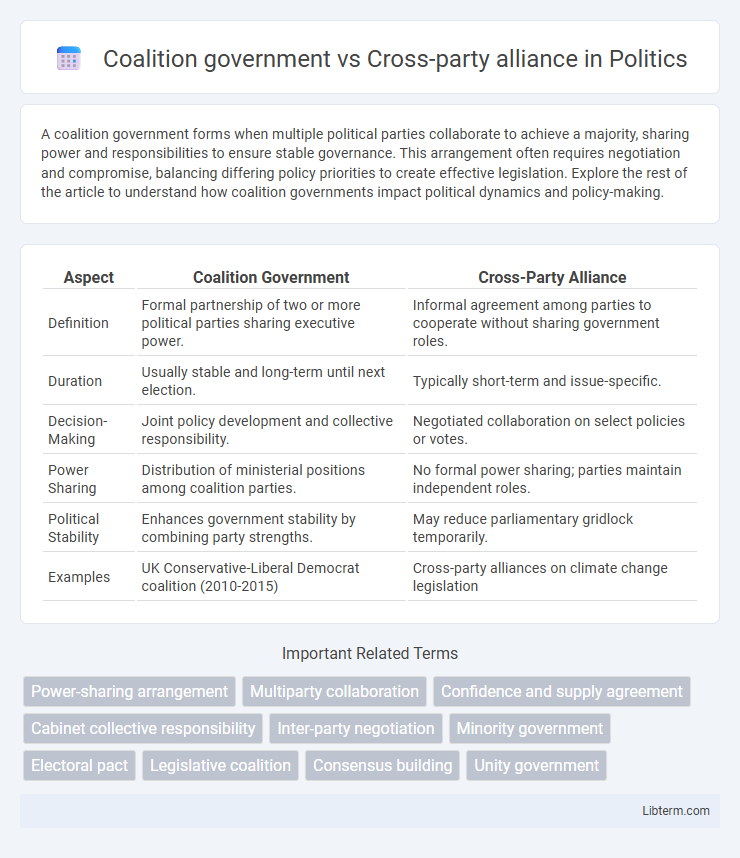A coalition government forms when multiple political parties collaborate to achieve a majority, sharing power and responsibilities to ensure stable governance. This arrangement often requires negotiation and compromise, balancing differing policy priorities to create effective legislation. Explore the rest of the article to understand how coalition governments impact political dynamics and policy-making.
Table of Comparison
| Aspect | Coalition Government | Cross-Party Alliance |
|---|---|---|
| Definition | Formal partnership of two or more political parties sharing executive power. | Informal agreement among parties to cooperate without sharing government roles. |
| Duration | Usually stable and long-term until next election. | Typically short-term and issue-specific. |
| Decision-Making | Joint policy development and collective responsibility. | Negotiated collaboration on select policies or votes. |
| Power Sharing | Distribution of ministerial positions among coalition parties. | No formal power sharing; parties maintain independent roles. |
| Political Stability | Enhances government stability by combining party strengths. | May reduce parliamentary gridlock temporarily. |
| Examples | UK Conservative-Liberal Democrat coalition (2010-2015) | Cross-party alliances on climate change legislation |
Definition of Coalition Government
A coalition government is formed when multiple political parties cooperate, sharing power to achieve a parliamentary majority, often after no single party secures an outright win. It involves formal agreements outlining policy compromises and distribution of ministerial positions among participating parties. This structure contrasts with cross-party alliances, which are typically less formal collaborations focused on achieving specific legislative goals without full power-sharing arrangements.
Understanding Cross-party Alliances
Cross-party alliances involve collaboration between members of different political parties to achieve specific legislative goals or address common issues without formally sharing power, contrasting with coalition governments where parties govern jointly. These alliances are typically issue-based and temporary, enabling diverse political actors to leverage their combined influence while maintaining separate party identities. Understanding cross-party alliances reveals their role in fostering bipartisan cooperation and navigating fragmented legislatures without the complexities of formal coalition agreements.
Key Differences Between the Two Systems
A coalition government is formed when multiple political parties agree to share executive power and jointly manage government functions, often including cabinet positions and policy responsibilities. In contrast, a cross-party alliance typically involves collaboration on specific issues or legislation without formal power-sharing or establishing a unified government. The key difference lies in the level of integration and commitment: coalition governments coordinate policymaking and governance collectively, while cross-party alliances maintain party independence while cooperating on common goals.
Formation Processes Explained
Coalition government formation involves formal negotiations among multiple political parties to establish a unified executive with shared policy commitments and a distribution of ministerial roles, typically occurring when no single party achieves a parliamentary majority. Cross-party alliances form more informally and often focus on collaboration for specific legislative goals or temporary issue-based cooperation without the establishment of a joint government or permanent power-sharing agreements. The coalition process requires detailed agreements and often extensive compromise, while cross-party alliances prioritize flexibility and issue-centric partnerships.
Power Sharing and Decision Making
A coalition government involves formal agreements between multiple political parties to share executive power and collectively make policy decisions, often requiring negotiated compromises and shared ministerial roles. Cross-party alliances typically form around specific issues or legislative goals without formal power-sharing arrangements, focusing instead on collaboration and consensus within parliamentary processes. Decision-making in coalition governments is more structured and institutionalized, whereas cross-party alliances rely on flexible cooperation and issue-based consensus.
Stability and Longevity Comparisons
Coalition governments often provide greater stability and longevity due to formal agreements that outline power-sharing arrangements and policy commitments, reducing internal conflicts. Cross-party alliances tend to be less stable as they are typically issue-specific and lack binding agreements, making them more susceptible to fragmentation. Historical data shows coalition governments in parliamentary systems frequently last the entire legislative term, whereas cross-party alliances often dissolve once the shared objective is achieved.
Advantages of Coalition Governments
Coalition governments enhance political stability by combining multiple parties to form a majority, reducing the risk of legislative deadlock. They foster broader representation, ensuring diverse viewpoints from various segments of society contribute to policy-making. This collaborative approach often leads to more balanced and inclusive governance, promoting compromise and consensus-driven decisions.
Benefits of Cross-party Alliances
Cross-party alliances foster collaboration among diverse political parties, enhancing policy innovation and broadening legislative support. By uniting different ideological perspectives, these alliances improve governance stability and facilitate comprehensive decision-making. The increased inclusivity of cross-party alliances also promotes public trust and mitigates partisan gridlock.
Real-world Examples and Case Studies
Coalition governments often involve formal agreements between multiple political parties to share executive power, as seen in Germany's Bundestag where the CDU/CSU and SPD have frequently formed coalitions to achieve legislative majorities. Cross-party alliances tend to be issue-specific collaborations without formal power-sharing, exemplified by the UK's 2019 parliamentary votes where Labour and Conservative MPs united to block no-deal Brexit scenarios. Examining Israel's 2021 coalition government demonstrates the complexity of multi-party governance, with diverse entities like Yesh Atid and Yamina negotiating policy compromises while maintaining distinct party identities.
Which Model Suits Modern Democracies?
Coalition governments, formed through formal agreements between political parties to share power, offer stability and policy coherence in multi-party systems, while cross-party alliances provide flexible cooperation on specific issues without long-term commitments. Modern democracies with fragmented electorates and proportional representation often benefit from coalition governments due to their structured power-sharing mechanisms. In contrast, cross-party alliances suit situations requiring agile consensus on urgent policy matters without altering government composition.
Coalition government Infographic

 libterm.com
libterm.com